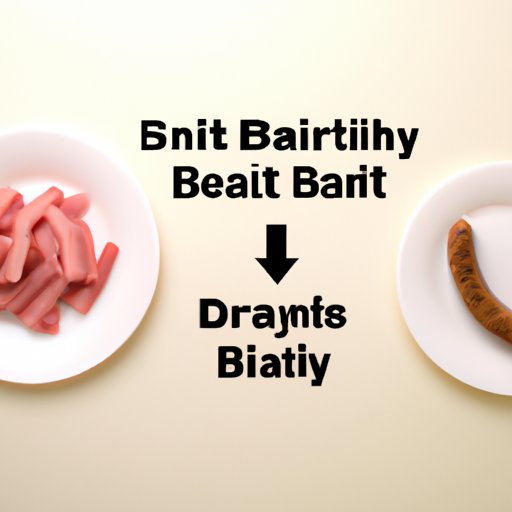Introduction
The BRAT diet – an acronym for Bananas, Rice, Applesauce, and Toast – has been widely recommended as a way to manage symptoms of gastrointestinal distress. The diet is low in fiber and contains foods that are easy to digest, making it a popular choice for those dealing with upset stomachs. But what exactly is the BRAT diet, and what are the benefits and risks associated with following it? This article will explore the basics of the BRAT diet, and discuss the pros and cons of incorporating it into your lifestyle.
Exploring the Benefits and Risks of a Brat Diet
The BRAT diet was initially developed by pediatricians as a way to help children who had recently suffered from bouts of vomiting or diarrhea. It is a bland diet that consists of foods that are low in fiber and easy to digest. While there is no scientific evidence that this diet is effective in treating gastrointestinal distress, many people have found it helpful in managing their symptoms.
What are the benefits of the BRAT diet? According to the American Academy of Pediatrics, the BRAT diet may help reduce nausea, vomiting, and other symptoms of gastrointestinal distress. Additionally, the low-fiber content of these foods can help reduce gas and bloating, as well as make digestion easier. Finally, the BRAT diet is high in simple carbohydrates, which can provide a quick source of energy when needed.
However, there are also some risks associated with the BRAT diet. For one, the diet lacks essential nutrients, such as protein and vitamins. Furthermore, the lack of fiber can lead to constipation and other digestive issues. Finally, the diet does not provide enough calories to sustain a person for more than a few days, so it should not be followed for an extended period of time.

A Guide to the Basics of a Brat Diet
So what foods are included in a BRAT diet? Bananas are the mainstay of the diet, along with rice, applesauce, and toast. Other foods that can be incorporated include cooked cereal, oatmeal, boiled potatoes, and yogurt. It is important to note that while these foods are generally considered safe, they should only be eaten in moderation and not used as a regular diet.
When it comes to how often you should follow this diet, it is recommended to only do so for a few days at a time. Any longer than that could lead to nutrient deficiencies. Additionally, it is important to consult with a healthcare professional before starting any type of dietary change, especially if you have a pre-existing medical condition.
Other considerations to take into account when following a BRAT diet include avoiding sugary snacks and processed foods, as well as drinking plenty of fluids. It is also important to replace lost electrolytes with sports drinks or other electrolyte-rich beverages.
How to Incorporate a Brat Diet into Your Lifestyle
If you’re looking to incorporate a BRAT diet into your lifestyle, there are several options available. One option is to adjust your current diet to include more of the foods found in the BRAT diet. This can be done by adding bananas, rice, applesauce, and toast to your meals, as well as replacing unhealthy snacks with ones that are BRAT diet friendly. Another option is to find recipes that incorporate BRAT diet friendly ingredients. There are many online resources that offer recipes tailored to the BRAT diet.

The Pros and Cons of Following a Brat Diet
As with any diet, there are both pros and cons to following a BRAT diet. On the plus side, the diet is low in fiber and easy to digest, making it a good option for those suffering from gastrointestinal distress. Additionally, the diet is rich in simple carbohydrates, providing a quick source of energy. On the downside, the diet lacks essential nutrients and can lead to constipation and other digestive issues if followed for too long.
Eating Healthy with a Brat Diet
It is possible to incorporate a BRAT diet into your lifestyle without sacrificing nutrition. To ensure that you are getting the necessary vitamins and minerals, try adding a variety of fruits and vegetables to your diet. Additionally, look for recipes that combine BRAT diet friendly ingredients with nutrient-dense foods, such as lean proteins, whole grains, and healthy fats. Finally, make sure to stay hydrated and drink plenty of fluids.

What You Need to Know About a Brat Diet
The BRAT diet is a short-term solution for those dealing with gastrointestinal distress. It can be beneficial in reducing symptoms such as nausea and vomiting, but it should not be followed for an extended period of time. Additionally, it is important to talk to a healthcare professional before starting any type of dietary change. Those who are pregnant, elderly, or have chronic conditions should seek medical advice before following a BRAT diet.
Conclusion
The BRAT diet is a popular choice for those dealing with gastrointestinal distress, as it is low in fiber and contains foods that are easy to digest. While there are benefits to following this diet, it is important to understand the risks associated with it, such as nutrient deficiencies and digestive issues. Additionally, it is important to incorporate healthy foods into your diet and consult with a healthcare professional before making any major changes. By understanding the basics of the BRAT diet and taking the necessary precautions, you can enjoy the benefits of this diet without sacrificing your health.
(Note: Is this article not meeting your expectations? Do you have knowledge or insights to share? Unlock new opportunities and expand your reach by joining our authors team. Click Registration to join us and share your expertise with our readers.)
